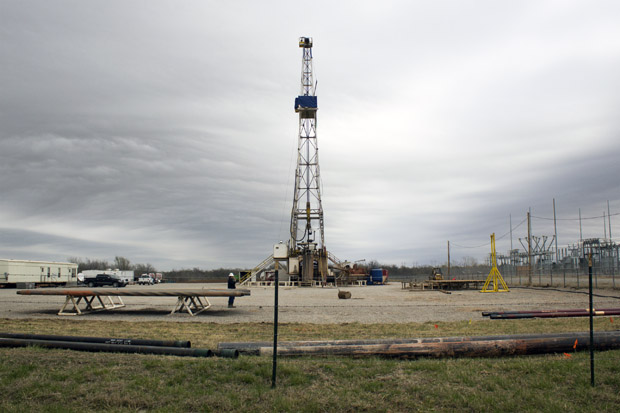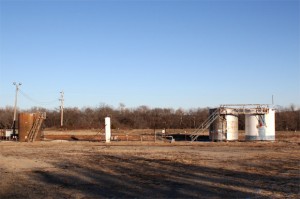Oklahoma Oil and Gas Regulator Uses Red Tape, Not Rules, to Manage Disposal Wells in Earthquake Country
-
Joe Wertz

Joe Wertz / StateImpact Oklahoma
Rig crews in Oklahoma City drilling a well.
As earthquakes continue to shake the state and researchers study links to drilling, Oklahoma’s oil and gas regulator has changed the way it approves permits for injection wells.
Oil and water have long mixed in Oklahoma and other petroleum states. In the early days of the U.S. oil boom, drillers were focused on finding ways to separate water from the oil they were pumping to the surface.
As decades passed, our understanding of the environmental impact of oil drilling changed. After the federal Clean Water Act and Water Quality Act went into effect in the ’70s and ’80s, state governments got serious about keeping oil and oilfield waste out of public water supplies.
One of the most effective ways to isolate saltwater, toxic drilling fluid and other hazardous oilfield waste fluid is to pump it into disposal wells so it can be stored deep underground, protected by layers of rock.
In Oklahoma, operators must get a permit from the Corporation Commission, the state oil and gas regulator, to drill or use injection wells.
“The process is based originally and largely on the whole idea of protecting water supplies,” says commission spokesman Matt Skinner. The whole process of applying for, contesting and approving injection well permits in Oklahoma is based on perceived risks to water supplies.
“Traditionally,” that’s the “No. 1 concern,” for the Corporation Commission, Skinner says.
But a new concern has emerged: earthquakes.
Permit Process
Oklahoma has experienced an exponential increase in earthquakes, and several peer-reviewed studies from university and federal scientists suggest injection wells themselves are likely causing many of the tremors.

Joe Wertz / StateImpact Oklahoma
Seismologists say oil and natural gas disposal wells, like this one near Sparks, Okla., are likely triggering earthquakes in Oklahoma.
The most recent research, released in March 2014, was the second academic paper to link injection wells to a 5.6-magnitude temblor that struck near Prague, Okla., in November 2011. That quake is the largest ever recorded in Oklahoma and appears to be the largest earthquake connected to injection wells.
In March 2014, Oklahoma’s three Corporation commissioners voted unanimously to adopt new data monitoring and reporting rules for operators of disposal wells in central Oklahoma’s earthquake-prone Arbuckle Formation. But when it comes to public safety rules, an investigation by StateImpact found that Oklahoma’s regulatory response has been more passive than other states that have experienced earthquakes suspected of being triggered by oil and gas activity.
The risk of injection wells triggering earthquakes has spurred the agency to subtly change the way it issues injection well permits, says Tim Baker, who manages the commission’s field operations and pollution abatement divisions.
“We have included a trigger, so to speak, for when we think we’re in an area that has a history of seismicity or is likely to have a history of seismicity,” Baker says. “We now ask for additional information on those applications.”
There are two ways to get an injection well permit in Oklahoma. The shortcut is through the Corporation Commission, which can administratively approve a permit. The long route is through the courts, an administrative law judge and, ultimately, the three commissioners.
The agency hasn’t changed any rules, but Baker says that it has changed how administratively approved permits — the easier, cheaper and faster type oil and service companies prefer — are issued for applicants who want to inject drilling fluid into disposal wells in earthquake-prone areas.
“If you are within a few miles [of earthquake activity], we’re going to ask for additional information before we proceed with the application,” Baker says.
If Baker’s team at the Corporation Commission is convinced the earthquake risk is low, it will use its administrative authority to approve the permit. If not, the operator can try to convince a judge in public court, Baker says. That hasn’t happened — yet.
‘Flatfooted’
So far, about a half-dozen operators have decided not to file applications when they learned, through informal meetings, that the Corporation Commission likely wouldn’t administratively approve the permit over earthquake concerns, Baker says. Currently, only one applicant has pressed on for a court hearing after the agency raised earthquake concerns, but the operator withdrew its permit application before the case was heard, records show.
For now, Oklahoma’s earthquake activity shows no sign of slowing — more than 1,400 have been recorded so far this year alone — and Corporation Commission officials expect that, eventually, an operator will have to argue in court for an injection well permit in a region deemed an earthquake risk.
And while only a handful of oil and service companies that have encountered the new, informal injection well permit hurdles, they’ve been caught “flatfooted,” Baker says.
“Except for the largest operators in the state, they really haven’t given it much thought,” he says. “They had no clue they were in an area that possibly could be contributing to the earthquake problems — it was news to them.”

